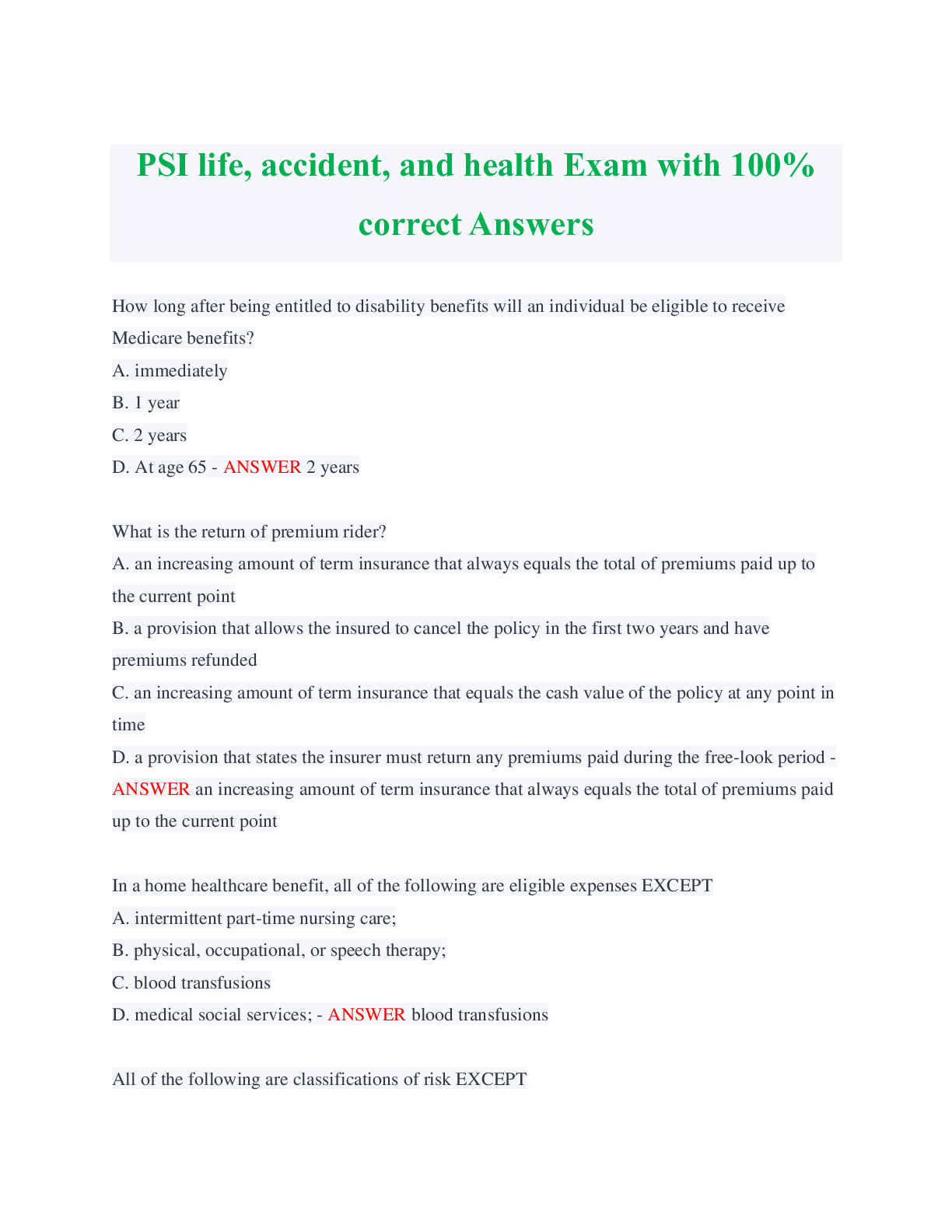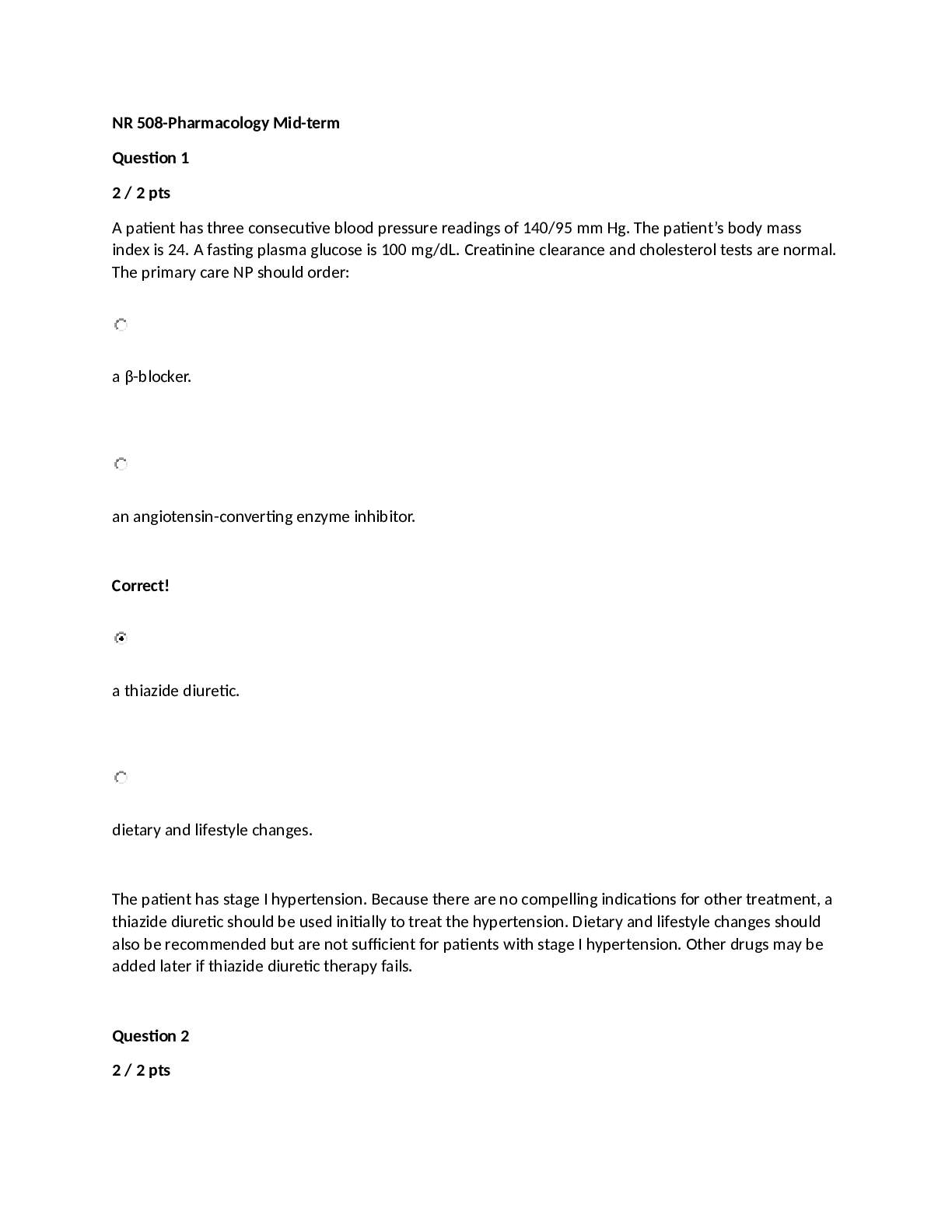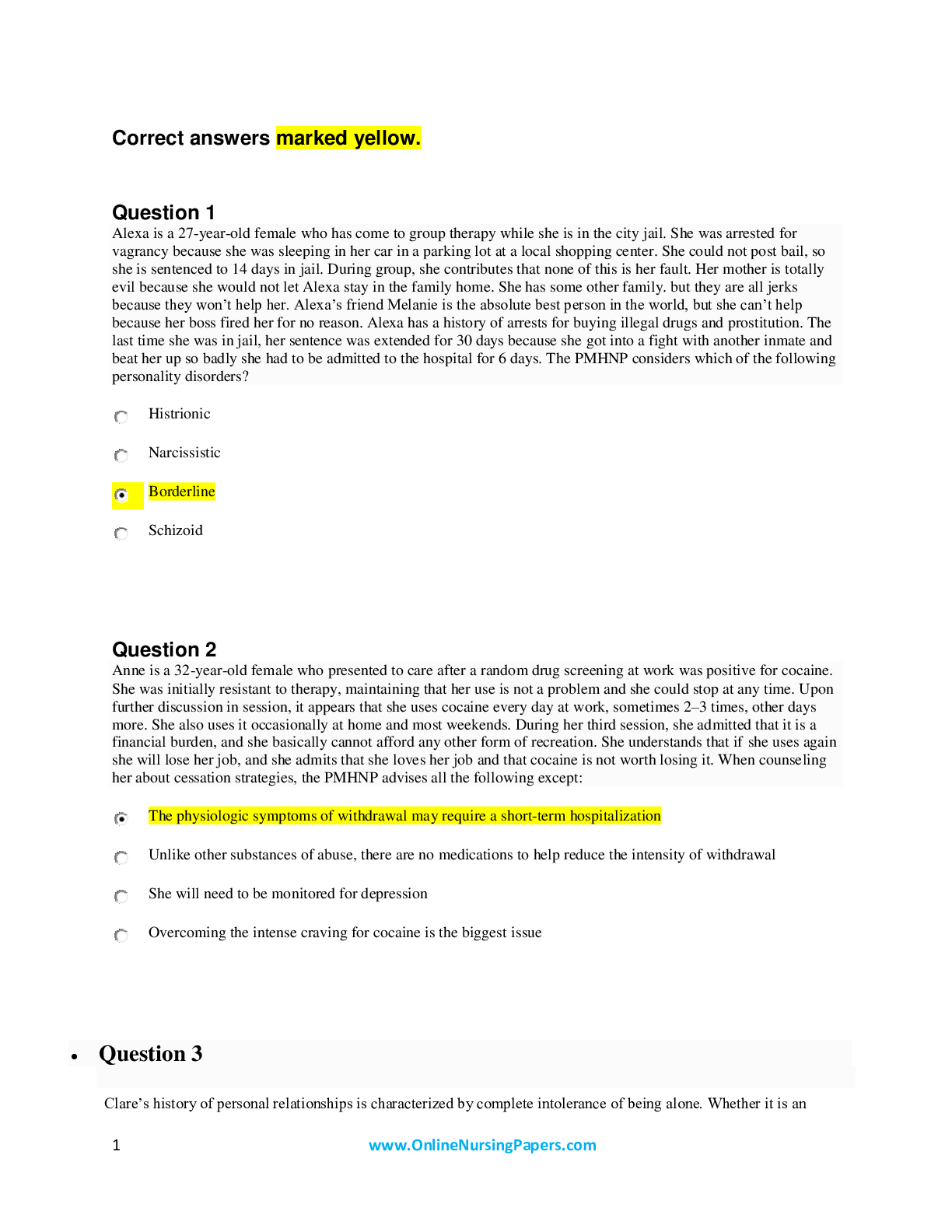PHTLS Post Test 9th 2022 Questions with correct Answers
Document Content and Description Below
The displacement of tissue away from the path of a projectile, both temporarily and permanently, is known as: - ANSWER Cavitation The single most important factor in determining the potential fo... r injury due to energy exchange is: - ANSWER Velocity of the bodies involved In the management of shock, isotonic crystalloid solutions, such as Ringer's, are preferred because: - ANSWER These solutions will stay in the vascular space longer than water solutions, such as D5W With respect to the distance of a fall, which of the following is a guideline for determining a critical fall? - ANSWER 3 times the height of the patient The phase of an explosion, or blast, in which hollow organs are squeezed and may rupture is called the __________ phase. - ANSWER Primary phase During the primary survey and management of a trauma patient, the E in ABCDE stands for _________? - ANSWER Expose/Environment The time in which surgical intervention can make a difference in patient outcome is the __________? - ANSWER Golden period (hour) In the absence of extenuating circumstances, the maximum amount of time it should take to identify and manage immediate threats to life, prepare the patient for transport and begin transport is _________? - ANSWER 10 minutes In which of the following situations is the use of a short spinal immobilization device indicated? - ANSWER None of the above Your patient is a 32 year old man, restrained driver of a vehicle that has been involved in a frontal impact with a concrete bridge abutment. The patient is awake, but has difficulty answering questions due to shortness of breath. His ventilatory rate is 30 per minute. Of the following choices, when is the first time the patient's breath sounds should be checked? - ANSWER Prior to being removed from the vehicle Which of the following represents adequate spontaneous ventilation in an adult? - ANSWER Tidal volume 600 mL, ventilatory rate 12/minute Which of the following is 100% accurate in verifying endotracheal tube placement? - ANSWER None of the above When utilizing percutaneous transtracheal ventilation, the correct ration of lung inflation to lung inflation time, in seconds, is: - ANSWER 1:4 Which of the following is a possible complication of using a manually triggered oxygen powered device for ventilation? - ANSWER All of the above Which of the following procedures is considered an essential airway - ANSWER Insertion of an oropharyngeal airway Pericardial tamponade is most likely to occur in which of the following situations? - ANSWER Stab wound to the chest Which of the following is the preferred site for needle decompression of a tension pneumothorax? - ANSWER 2nd intercostal space, midclavicular line, just over top of the 3rd rib Which of the following is the mechanism by which pulmonary contusion interferes with oxygenation? - ANSWER Blood and fluid in the alveoli and interstitial spaces of the lung Your patient is a 55 year old male who was struck in the right side of the chest with a piece of steel pipe. He presents with uncooperative behavior, his skin is pale and moist, the ventilatory rate is 32, there is a weak radial pulse of 112, and breath sounds are decreased on the right side. The trachea is midline and jugular veins are flat while the patient is supine. There is isolated crepitus over the 4th and 5th ribs in the midaxillary line on the patient's right side. Based on the mechanism of injury and the assessment findings, which of the following is the most likely cause of the patient's signs and symptoms? - ANSWER Hemothorax Deterioration of ventilation and oxygenation after inflation of a PASG in a patient who has sustained a high-pressure compression injury of the abdomen, such as a sudden deceleration with the lap belt placed across the abdomen, most likely represents which of the following - ANSWER Ruptured diaphragm Which of the following is NOT a component of the Fick principle? - ANSWER Adequate number of platelets in the blood One of the earliest signs of hypovolemic shock - ANSWER Anxiety Which of the following characterizes the washout phase of shock? - ANSWER Systemic acidosis A trauma patient who has fallen 20 feet from an apartment balcony is alert with warm, dry, pink skin, with normal capillary refilling time to the lower extremities, and is hypotensive. The upper extremities are cool, pale and diaphoretic. Which of the following injuries should be suspected? - ANSWER Spinal cord injury Which of the following is a limitation of prehospital fluid resuscitation of the patient in hemorrhagic shock? - ANSWER All of the above Which of the following statements regarding signs of intraabdominal injury is NOT true? - ANSWER Substantial intraabdominal hemorrhage always causes tenderness and abdominal rigidity Which of the following assessment techniques is least useful in the prehospital assessment of the patient with suspected intraabdominal trauma? - ANSWER Auscultation Pregnant trauma patients should be placed on the left side because: - ANSWER This prevents compression of the vena cava Survival of the fetus in a trauma situation is most dependent upon which of the following factors? - ANSWER Good resuscitation of the mother A patient struck in the back of the head with a baseball bat may sustain a cerebral contusion to which area of the brain? - ANSWER Occipital (probably too low velocity for Coup & Contre Coup) In the context of the caring for an adult patient with traumatic brain injury who is deteriorating and exhibiting signs of herniation, hyperventilation means ventilating with a BVM and 100% oxygen at a rate of: - ANSWER 20 In the United State, which of the following mechanisms most frequently causes spinal cord injury in adults? - ANSWER Vehicle crashes Which of the following presentation indicate spinal cord injury? - ANSWER All of the above Of the following, which is the earliest indication of compartment syndrome? - ANSWER Tense swelling of the involved area A traction splint may be used for which of the following - ANSWER Femur fractures Which of the following descriptions meets the criteria for transport to a facility with a burn unit? - ANSWER A 25 year old male with an electrical burn across his chest The preferred method of dressing burns in the prehospital setting is: - ANSWER Dry sterile dressing In assessing the hypothermic patient in the prehospital setting, the most reliable indicator of the severity of hypothermia is: - ANSWER Rectal temperature In the normal child, which general statement is most accurate in comparison with the adult patient? - ANSWER Blood pressure is lower, heart rate is higher, and ventilatory rate is higher A patient who withdraws from painful stimuli, opens eyes on verbal command, and cannot speak because of intubation has a Glasgow Coma Scale of which of the following: - ANSWER 8T (E-3, V-T, M-4) The earliest site for intraosseous infusion is: - ANSWER Anterior tibia, just below the tibial tuberosity Which of the following behaviors is the most reliable indication of confusion in the elderly patient - ANSWER Inability to recall his/her name In the elderly trauma patient a high index of suspicion for shock should occur beginning when the systolic blood pressure is less than: - ANSWER C. 120 mmHg In an adult patient, blood loss into the tissue from a fractured femur may be as much as which of the following? - ANSWER 1000 2000 mL Delayed death due to trauma is usually a result of: - ANSWER Biochemical and pathophysiological effects of inadequate initial resuscitation A regional resource center with a full spectrum of trauma services from prevention to rehabilitation which serves as the leader in trauma care for a geographical region is - ANSWER Level I trauma center Which of the following patients is not indicated for spinal immobilization? - ANSWER Patient with a knife wound to the chest and a GCS of 15 The premise of PHTLS is that: - ANSWER EMTs are capable of sound patient care judgment, given an adequate knowledge base Which of the following warrants classification of a patient as a critical trauma patient? - ANSWER Preexisting major medical problem Which of the following is the foundation of effective trauma care? - ANSWER The ability to quickly locate and manage life-threatening and potentially life-threatening injuries You arrive at the scene of a motor vehicle collision in which a vehicle struck a tree. Which is the best indicator of potential injury? - ANSWER Speed of the vehicle The potential for death or serious injury is greatest in which of the following motor vehicle collisions? - ANSWER Ejection from vehicle Bilateral femur fractures are most often associated with which type of motorcycle crash? - ANSWER Head-on impact Which is the preferred fluid for resuscitation of hemorrhagic shock in the prehospital setting? - ANSWER Lactated Ringer's Which is the most common cause of upper airway obstruction in the trauma patient? - ANSWER Tongue Which is the preferred adjunct device for verifying placement of an endotracheal tube in a patient with a perfusing rhythm? - ANSWER End-tidal CO2 monitoring (capnography) Which is the most important reason to maintain an open airway in the trauma - ANSWER Prevents hypoxemia and hypercarbia Essential airway skills include manual clearing of the airway, manual maneuvers, suctioning and which of the following? - ANSWER Oropharyngeal airway Your patient is a middle aged male who crashed his motorcycle. He is unresponsive. After opening the airway using a modified jaw thrust, you note the patient has respirations at a rate of 6. Auscultation reveals breath sounds are absent on the left side. Which of the following is the most appropriate next intervention? - ANSWER Begin ventilation with a BVM Which best describes shock? - ANSWER Generalized inadequate tissue perfusion Your patient has a deep laceration to his antecubital fossa with significant bleeding. What is the most appropriate initial action? - ANSWER Apply direct pressure Hypotension of unknown etiology in a trauma patient should be assumed to result from which of the following? - ANSWER Blood loss Which assessment is most beneficial in differentiating hemorrhagic shock from neurogenic shock in the prehospital setting? - ANSWER Skin The body initially compensates for blood loss through activation of which of the following? - ANSWER Sympathetic nervous system Medication used by trauma patients for pre-existing conditions may cause which of the following? - ANSWER Beta blockers may prevent tachycardia with blood loss The target blood pressure for a trauma patient with suspected intraabdominal hemorrhage is which of the following? - ANSWER 80 - 90 mm Hg Which best explains the mechanism by which gas exchange is impaired in pulmonary contusion? - ANSWER Blood in the alveoli Which of the following is a key finding that differentiates cardiac tamponade from tension pneumothorax? - ANSWER Equal breath sounds Your patient is a 20 year old male who struck his head on a teammate's knee while diving to catch a football. He was not wearing a helmet. He demonstrates decerebrate posturing and has a GCS score of 4. His heart rate is 58, blood pressure 180/102 and his left pupil is dilated. What is the best ventilation rate to use when managing this patient? - ANSWER 20 breaths per minute A 20 year old female was ejected from her vehicle during a high speed roll-over motor vehicle collision. She has significant bleeding from a large laceration. Your initial assessment reveals a GCS score of 7, systolic blood pressure of 70 mm Hg and pupils that are equal but respond sluggishly to light. After establishing two large bore IV lines, you should titrate the infusion rate to achieve a target blood pressure of at least - ANSWER 90 mm Hg. Which of the following is the preferred prehospital wound management for a patient with a 36% body surface area flame burn? - ANSWER Dry sterile dressings The most immediate life threatening condition resulting from injury to solid abdominal organs is which of the following? - ANSWER Hemorrhage. An adult male sustained a deep laceration to his distal thigh. Bright red blood is spurting from the wound. Direct pressure is not controlling the bleeding. What is the most appropriate next step? - ANSWER Apply a tourniquet and tighten it until bleeding stops An 18-year-old female was struck by a car and has sustained an apparent left femur fracture. Communication with her is hampered because she only speaks a foreign language. Which finding, by itself, does not mandate immobilization of the cervical spine? - ANSWER Mechanism of injury During the primary survey of a trauma patient, you note that the patient is agitated and confused, and has multiple injuries from an altercation. Which of the following choices is the most appropriate first treatment ? - ANSWER Correction of possible hypoxia [Show More]
Last updated: 2 years ago
Preview 1 out of 9 pages

Buy this document to get the full access instantly
Instant Download Access after purchase
Buy NowInstant download
We Accept:

Reviews( 0 )
$8.00
Can't find what you want? Try our AI powered Search
Document information
Connected school, study & course
About the document
Uploaded On
Sep 02, 2022
Number of pages
9
Written in
Additional information
This document has been written for:
Uploaded
Sep 02, 2022
Downloads
0
Views
62

















.png)


.png)





